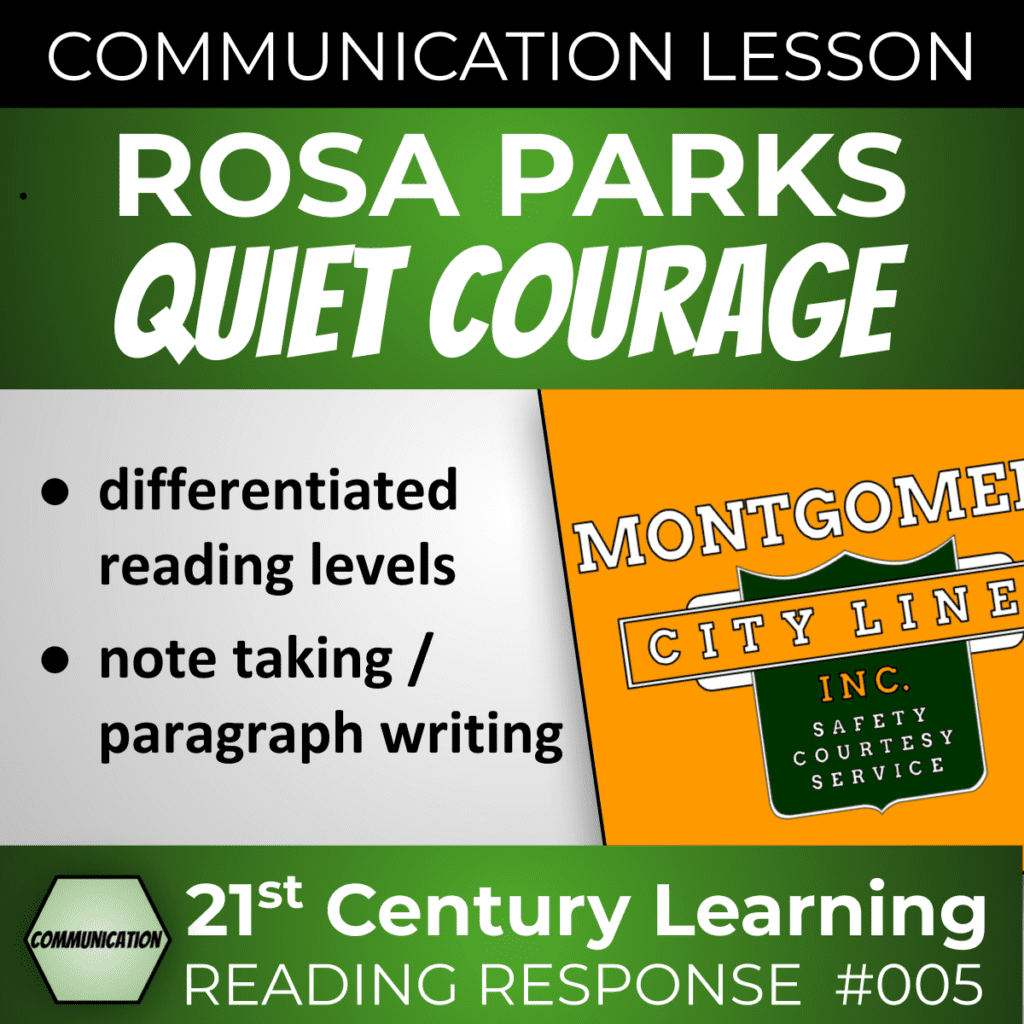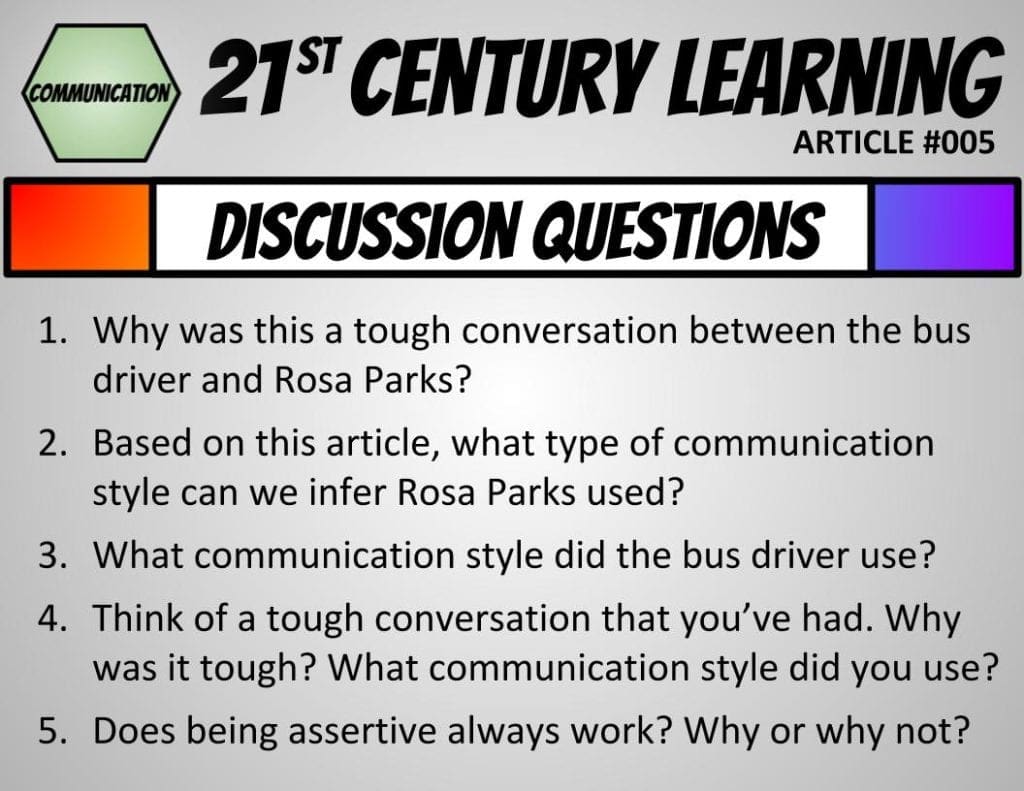Rosa Parks – Quiet Courage (Reading Response Article 005) – Assertive Communication Lesson
Download the lesson
- printable article handout
- differentiated reading levels
- note taking and paragraph writing handout package
- assessment rubric
- sample student answers
Newsletter Bonus
If you subscribe to the Educircles Newsletter, check your email for a special link to our Google Drive folder to download the handouts (Link expires in one week.)
Not a subscriber yet? Check out what our newsletters look like.
Rosa Parks Communication Lesson – Background Information / Historical Context
Rosa Parks is famous for her role in the US civil rights movement. Although we often talk about her during Black History Month, we can learn from her example of “quiet courage, dignity and determination” (8) at any time of the year.
In 1955, the buses in Montgomery, Alabama were segregated based on the colour of your skin. The first four rows of seats on the bus were reserved for people who were White. People who were Black would pay their fare at the front, but then have to get off the bus only to board again through the back doors.
If the front section was filled, people who were Black would have to move back. They were not allowed to sit in the same row with people who were White. If the bus got full, the driver had the authority to move people who were Black and make them give up their seats to make room for people who were White.
We know that Rosa Parks refused to give up her seat to a White man. As a result, she was arrested and put in jail. This was the catalyst that sparked bus boycotts across the city.
During the Montgomery Bus Boycotts, for 381 days, people who were Black and other supporters chose not to take the bus. They walked or got rides instead of paying to ride the bus. Reverend Martin Luther King Jr was the spokesperson for the boycott and stressed the importance of nonviolence by all participants.
Eventually, in 1956, the US Supreme Court would rule that bus segregation was unconstitutional and illegal. The city of Montgomery was forced to integrate their transit system.
Forty years later, the President would award Rosa Parks a gold medal on behalf of the Congress in recognition of her contributions to the Nation. She would be called the “mother of the freedom movement” and ‘‘first lady of civil rights’’

Although we could talk about Rosa Park’s courage and strength of character to stand up for equal rights by choosing to sit down and not give up her seat because she was Black, in this article, let’s focus on that one moment on the bus when she communicated with the bus driver to let him know she wasn’t going to give up her seat.
5 Things you need to know:
- Rosa Parks was 42 years old at the time of her arrest and was planning a major youth conference as part of her work with the National Association for the Advancement of Colored People (NAACP).
- She was sitting in the front row of the Segregated section. When more people who were White boarded the bus, the bus driver asked the people who were Black in the front row of the Segregated section to give up their seats.
- Three people gave up their seats and moved further back. Rosa Parks chose not to.
- None of the people on the bus who knew her did anything. They didn’t even tell her husband that she was arrested.
- Rosa Parks was not the first person in Montgomery to be arrested for not giving up their seat to a person who was White.
Watch the Video:
Click here for the YouTube video link.
5 Quotes from conversations on the bus:
Quote #1:
Rosa Parks describing what happened on the evening of Thursday, December 1, 1955
“…I was riding the bus home from work. A white man got on, and the driver looked our way and said, “Let me have those seats.” It did not seem proper, particularly for a woman to give her seat to a man. All the passengers paid ten cents, just as he did. When more whites boarded the bus, the driver, J. P. Blake, ordered the blacks in the fifth row, the first row of the colored section (the row I was sitting in), to move to the rear. Bus drivers then had police powers, under both municipal and state laws, to enforce racial segregation. However, we were sitting in the section designated for colored.
SOURCE: Page 13
Quote #2:
The bus driver wanted people who were Black to give up their seats. 3 of the people gave up their seats and moved to the back. Rosa Parks moved closer to the window.
Y’all better make it light on yourselves and let me have those seats
SOURCE: J.P. Blake (bus driver) as quoted by Rosa Parks (Page 13)
Quote #3:
No. I am not.
SOURCE: Rosa Parks in response to the bus driver asking her if she was going to stand up. She talks about this moment in her book: “I knew someone had to take the first step. So I made up my mind not to move.”
Quote #4:
Go ahead.
SOURCE: Rosa Parks in response to the bus driver saying that he would have to call the police.
Quote #5:
Why do you push us around?
SOURCE: Rosa Parks asking the police officer arresting her.
I don’t know, but the law is the law and you’re under arrest.
SOURCE: Arresting police officer as quoted by Rosa Parks (Page 14)
5 Reflections by Rosa Parks to think about:
Reflection #1
I knew there was a possibility of being mistreated, but an opportunity was being given to me to do what I had asked of others.
Page 13
Reflection #2
Though I knew we needed to strive for nonviolence, when I saw the brutal treatment some of us got, I had trouble believing it was always the best thing to do.
Page 31
Reflection #3
When I reflect on conditions in the South, I recall that people had become worn out from being humiliated. They were sick of accepting the racial segregation that seemed to be worsening each day. Someone had to take that first step.
Page 26
Reflection #4
Human dignity must be respected at all times. I would have compromised my dignity if I had buckled one more time… I also would have compromised my dignity if I had resisted violently.
Page 26
Reflection #5
There were other people on the bus whom I knew. But when I was arrested, not one of them came to my defense. I felt very much alone… In jail I felt even more alone. For a moment, as I sat in that little room with bars, before I was moved to a cell with two other women, I felt that I had been deserted.
Page 14
Rosa Parks – Communication Mini-Lesson
We’ve all had tough conversations – when you want something and the other person you are communicating with wants something else.
Just because you disagree about something doesn’t always make a conversation tough. For example, if you want to see an action movie and your friend wants to watch a comedy, but it doesn’t really matter to either of you, then we don’t really have any conflict.
Tough conversations happen when you want something, the other person wants something else, and this is important to both of you. Now what?
Here are four styles of communication in tough conversations.
They differ based on what outcome you’re working towards – who “wins” and who “loses.”
1. ASSERTIVE communication style: The Diplomat
- You could be “the diplomat” (assertive) where your needs come first in a respectful way.
- You win because you set personal boundaries and limits on what you’re willing to do/accept.
- You’re also working to help the other person win because you’re trying to find a solution that works for them (as long as you don’t compromise your personal boundaries/limits.)
2. AGGRESSIVE communication style: The Steam Roller
- You could be “the steamroller” (aggressive) where your needs come first no matter what – you win, and they lose.
3. PASSIVE-AGGRESSIVE communication style: The Rain Cloud
- You could be “the rain cloud” (passive-aggressive) where their needs come first (begrudgingly with indirect resistance).
- They win, and you might win or lose depending on what the other person does because of how unhappy you act or pushback.
4. PASSIVE communication style: The Door Mat
- Finally, you could be “the doormat” (passive) – they win, and you lose. You avoid confrontation at all cost.

Communication Discussion Questions
Based on this Communication mini-lesson, how would you answer the following questions:
- Why was this a tough conversation between the bus driver and Rosa Parks?
- Based on this article, what type of communication style can we infer Rosa Parks used?
- What communication style did the bus driver use?
- Think of a tough conversation that you’ve had. Why was it tough? What communication style did you use?
- Does being assertive always work? Why or why not?

Free Rosa Parks Communication Lesson Slideshow
Link to resources used in this article:
- Reflections by Rosa Parks
- Bus Diagram from US National Archives, public domain: https://www.archives.gov/education/lessons/rosa-parks
- Video: https://youtu.be/h4Oi0BtvZps
- Educircles Communication Lesson Plans
Author’s Notes
About the title:
The title of this article, “Quiet Courage, Dignity and Determination” is a great phrase that comes from the forward of the book Reflections by Rosa Parks.
About the language used in this lesson:
Where possible, I used primary source information including direct quotes, words and language used by Rosa Parks from her book Reflections.
To highlight some of the inequities, I have chosen to use people-first language where possible, outside of direct quotes.
I have also decided to capitalize “Black” and “White” in this article when referring to groups of people. DiversityInc does a great job explaining why the B is capitalized at their organization. However, I felt it was also important to capitalize the “W” in people who are White.
Why? Because I want my students who are Black, White, Asian, Ecuadorian, Arab or Israeli to feel valued and respected. Chances are, you do too.
(FYI the American Psychological Association has a fantastic article about bias-free language when referring to racial and ethnic identity.)






